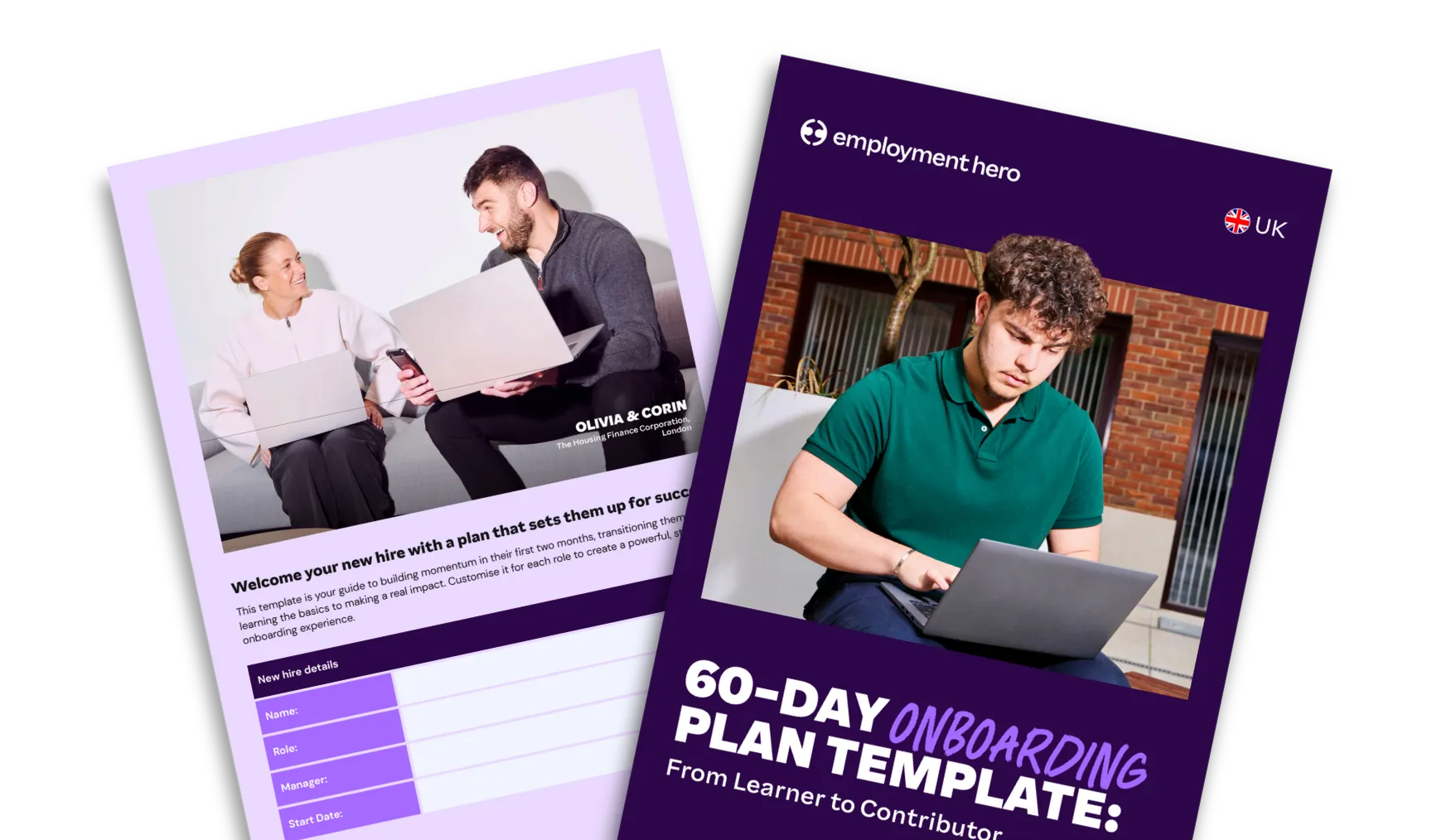Performance improvement plan template and guide
Published
Performance improvement plan template and guide
Do you have a team member who is falling behind? Maybe the quality of their work has taken a tumble or they’re not meeting the basic requirements of their role?
It’s a tough scenario for managers and employees to be in, but there are ways that you can improve the situation. A performance improvement plan (PIP) is one of the most common tools that employers use to help their team members recover their performance.
How can this PIP template help?
This sample performance improvement plan can help you bring structure and consistency to this process. This worksheet is designed to help you and your employee find transparency in the situation, and make an actionable plan to move forward with.
In this employee action plan template, we’ve provided a structure to outline;
- A description of the underperformance occurring
- Required outcomes and areas for improvement
- Strategies to improve performance and the support leadership can provide
- Consequences if the performance objectives are not met
What is a performance improvement plan (PIP)?
A performance improvement plan (PIP) is designed to help identify and work through current performance issues whereby an employee isn’t meeting company expectations.
The plan clearly outlines specific areas of concern, helps to clarify expectations, as well as notes the expected outcomes if the performance benchmarks are or are not met.
Performance improvement plans help employees improve within their roles, and they can also reduce turnover.
To further enhance your performance review process, consider using our Employee Performance Review Template Bundle.
This bundle includes a self-evaluation and professional development template, providing a comprehensive approach to performance reviews.
PIPs often form part of a formal capability process under employment law. Employers should ensure they follow the ACAS Code of Practice when implementing a PIP, especially where disciplinary action or dismissal may follow. Proper documentation and fair procedures are critical.
Why use performance improvement plan templates?
An improvement plan template can lay out the requirements for the performance improvement plan in a consistent and transparent manner.
Filling out this template with your employee ensures they know exactly what’s expected to move forward. They will also be more aware of the support that is available,and how they can measure their progress.
For documenting and progressing your employees in the workplace, a Professional Development Plan Template can help HR managers create effective professional development plans.
A structured PIP can also help defend against unfair dismissal claims under UK law, as long as the employer can demonstrate that the plan was fairly designed, communicated, and reviewed.
How long should performance improvement plans go for?
Generally, a performance improvement plan will span eight to ten weeks from the plan’s start date, which is often marked by a meeting to discuss the plan. Giving this kind of timeframe can help spur the employee into action, rather than having the improvement plan feel like some kind of abstract future event.
Keeping a limit on the time frame and providing measurable objectives can help your employee meet expectations.
Halfway point evaluation
We strongly recommend checking in with your employee at the halfway point, four to five weeks in. When you do so, use the performance review plan template that you’ve filled in as a reference. Go through each point and talk about the employee’s progress, noting any further areas that they may need support in.
Remember to have a formal halfway evaluation.

Remember to have a formal halfway evaluation. Caption: Photo by Mimi Thian on Unsplash
Step-by-step: Implementing performance improvement plans
Here’s a quick breakdown of how to complete each section of this performance improvement plan template:
- Performance concern: Clearly state the issue (e.g. missed deadlines, poor communication, etc.) and give specific examples with dates
- Expected outcome: Describe the standard the employee is expected to meet. Use measurable goals wherever possible
- Action plan: Outline the steps the employee will take and the support the company will provide (e.g. training, regular check-ins, mentoring)
- Timeline: Define the PIP duration and any milestone check-ins. Track progress at regular, agreed intervals
- Consequences: Be clear about what may happen if the employee’s performance gaps are not closed (e.g. escalation to a formal disciplinary process)
- Review and sign-off: Include space for both parties to acknowledge the plan and agree to the expectations for the improvement process
Performance improvement plan examples
Within our performance improvement plan templates you’ll find the best way to structure your staff performance improvement plan. In the first column, you should detail the problem, then provide actionable steps to address it.
Let’s look at a few common examples of what kind of issues might trigger an employee performance improvement plan and how you might articulate them.
1. Often misses deadlines
The ability to meet deadlines is critical in many lines of work, so if deadlines are consistently being missed, this would be a fair cause for concern. Within your performance improvement plan, make sure you’re specific about the deadlines missed and the impact to the business as a result.
For example: You have missed several editorial print deadlines,notably on 8, 21 and 30 November. This has caused stress for other team members who have had to provide last-minute content to fit the empty placements. It has also meant that we cannot stick to our overall editorial plans, which then need to be amended and updated.
From there, you can outline measurable steps to help the person set up an efficient workflow, and identify additional support required to improve.
2. Has received negative feedback from clients or customers
Customer and client satisfaction is everything to a business, so if you have a public-facing employee who is frequently receiving bad feedback, this is a significant problem.
As above, be specific about what kind of feedback has been received, and the consequences for the employee and the business.
For example, you have received six negative reviews from customers during August and September, many of whom said that you did not speak to them in a respectful manner. This can affect your personal reputation and that of the business, causing our customers to lose trust and motivating them to take their patronage elsewhere.
An action item for this behaviour could include shadowing a more experienced customer-facing person or doing practice phone calls or conversations with a manager.
3. Delivering a low quality of work
Sometimes our quality of work can take a turn for the worse. Maybe we’re missing important details, not following guidelines or making lots of grammatical or data errors.
Being specific means giving clear examples of where they’ve made mistakes.
If someone is underperforming, be specific about the issue and the impact. For example, “You’ve submitted three consecutive monthly reports with incorrect sales data. This has affected strategic decision-making across the business and resulted in inaccurate reporting to senior leadership. That poses a high risk to operations.”
From here, you might introduce a process where someone else reviews their reports before submission, or ask them to review their workflow to identify where the errors are happening. Make it clear that they have your support as they work to improve.

Photo by Christina @ wocintechchat.com on Unsplash.
How to create a performance improvement plan
Issuing an employee improvement plan is no fun for the employee or the manager involved, but the hope is that it has positive outcomes.
It’s important to remember that, in almost all circumstances, poor performance isn’t intentional. Never discuss performance issues when you are angry, or you lose any chance of a constructive conversation and quickly turn your team member into a ‘flight risk’ employee.
Employees who are performing badly need your support to improve and help them monitor progress. Here are some ways that you can help struggling employees get back on their feet.
Try to identify what’s causing poor employee performance issues
If poor work performance isn’t intentional, what could be driving it? It’s always better to treat the cause, not the symptoms. During your performance improvement plan meeting, it’s important to try to identify the root cause of the problem.
Before implementing a PIP, consider whether an informal conversation, coaching, or additional support may be more appropriate. It’s best practice to attempt informal resolution before formal procedures. The goal, as always, is to help the employee meet job expectations, and hit the right performance metrics. If an informal meeting would be enough to help the employee reach the expected performance level, then you can go this route instead to start.
Management expert Bernard Marr wrote about the seven common causes of poor performance:
Resources
Does your team member lack the tools, equipment or time to complete a task? Then it’s likely a lack of resources is leading to a slowdown in their work.
Obstacles
Is there a lot of red tape within your business that stops things from moving forward? Maybe your interdepartmental relationships are slowing progress and your employee doesn’t know how to navigate them.
Skills
A lack of skills and knowledge could be stopping your team members from performing. Perhaps they were given a new role or responsibilities without additional training, or they need some mentorship to help them learn the ropes.
Expectations
A lot of the time, it’s simply a lack of understanding that can be the culprit. If the employee doesn’t understand the company’s expectations or what is critically required of them in their role, they’re never going to catch up.
‘No carrots’ (a lack of reward and recognition)
Reward and recognition is critical to keeping employees motivated and performing well. If their progress milestones and achievements consistently go unnoticed, it’s very likely that they will disengage from their work.
‘No sticks’ (a lack of accountability)
As a manager, do you often let sub-par work slide? Do you feel like you don’t have time to give feedback and it’s ‘good enough’. You’re actually doing your employees a disservice. Performance improvement plans can be avoided if managers give constructive feedback regularly.
Burnout
Burnout is a global issue, with our Wellness at Work Report finding that 58% of employees had recently experienced burnout. This could be a sign that the employee needs a different approach to how they work.
Personal reasons
This reason was not on Marr’s original list, but we feel it’s worth flagging. If your employee has recently gone through a difficult personal event it may be causing them to disconnect from their work.
For example, if someone is experiencing grief from the death of a loved one, they may be feeling distracted or have a lack of mental capacity for work. This doesn’t mean that you can’t talk to them about their performance or give them a performance action plan, but it does give you as a manager valuable context to their current challenges. You can then organise mental health resources or additional accommodations that might be required.
Is someone on your team experiencing grief? Support them in a meaningful way by downloading our Leader’s Guide to Grief.
Speak kindly and with empathy
Remember the old saying, you catch more flies with honey than with vinegar?Walking into a performance improvement plan meeting, the last thing you want to do is start an argument or make the person receiving feedback cry. Try to remove any sense of frustration or anger, this person needs your help to improve – the only outcome of making them feel guilty or upset will be further disconnection from you.
Give honest feedback in a kind manner
Be honest with the person when it comes to your feedback and expectations, but deliver it in a kind way. Put yourself in their shoes and listen carefully when they tell you what they need to improve.
Be there to support their improvement
The whole point of an employee performance improvement plan is to give that struggling employee the best chance of success.
If you give your team member a performance action plan but then you don’t do anything to assist them, it’s unlikely that they’ll be able to meet their improvement goal. Although you should have your formal halfway point progress evaluation, it’s also important to host regular check ins and give helpful feedback.
Are you hosting 1:1 meetings?
Do you have a 1:1 meeting system in place with them already? If not, start conducting these meetings weekly. Open the conversation to understand how their work is going and offer them any helpful tips or advice to achieve their goals. Regular 1:1 meetings are essential for employee success.

Regular 1:1 meetings are essential for employee success. Photo by Christina @ wocintechchat.com on Unsplash.
To set clear and achievable goals for your employees, you can consider using an Employee Goal Setting Template, which helps employees define their career goals for the next decade.
What happens if an employee improvement plan doesn’t help?
Unfortunately, despite everyone’s best efforts, there will be some occasions where the employee fails to improve after being issued a performance improvement plan.
During the performance improvement plan meeting, you as a manager need to be extremely clear on how you will measure success around improvement and give clear expectations on what the consequences will be if your team member fails to improve.
Generally, a possible termination of employment is the outcome of a failed performance improvement plan. However, it’s important to note that this should always be a last resort outcome. You want to reduce staff turnover as much as possible within your business.
Employers must follow a fair process before any dismissal. This includes giving employees the opportunity to improve, reviewing the plan outcomes objectively, and allowing the right to appeal. Termination without due process may lead to an unfair dismissal claim under UK employment law.
Employee rights during a performance improvement plan
Employees have several important rights during a performance improvement plan:
- The right to be informed of concerns in writing
- The right to be accompanied to formal meetings by a colleague or trade union rep
- The right to reasonable adjustments (if they have a disability or health condition)
- The right to appeal decisions made as a result of the PIP
Employers should document all meetings, provide regular updates, and avoid treating the performance improvement plan as a foregone conclusion. The goal should be to improve any performance issues, it should not be discipline.
Stop bad performance in its tracks
In an ideal world? We’d stop bad performance as soon as it starts to appear and avoid a performance improvement plan altogether.
The best way to do this is to improve your performance management process. Ask yourself these questions to run a quick evaluation;
- Are you regularly giving feedback to your employees (and encouraging them to give feedback back to you)? Don’t rely on once yearly performance reviews, keep feedback moving in a constant loop.
- Are you setting clear expectations with a performance framework like Objectives and Key Results (ORKs)?
- Are you using a performance management process template to implement personal improvement plans effectively?
- Are you using performance management software to create a clear record of your employee’s feedback and success?
If you’d like to learn more about how you can make performance management a key part of your team operations, learn more about our high-impact performance management software.
Book a demo with one of our business specialists to find out more.
Download your template below
Related Resources
-
 Read more: Predictive Modelling in HR: Stop Guessing, Start Winning
Read more: Predictive Modelling in HR: Stop Guessing, Start WinningPredictive Modelling in HR: Stop Guessing, Start Winning
Discover how predictive modelling in HR can transform decision-making. Learn about key models, algorithms and steps to implement predictive analytics.
-
 Read more: Team Cohesion: The Ultimate Toolkit For Cross-Functional Collaboration
Read more: Team Cohesion: The Ultimate Toolkit For Cross-Functional CollaborationTeam Cohesion: The Ultimate Toolkit For Cross-Functional Collaboration
Learn how to build team cohesion and improve cross-functional collaboration. Discover actionable strategies, team-building activities and key behaviours.
-
 Read more: Your 60 day onboarding plan: The free template for building momentum
Read more: Your 60 day onboarding plan: The free template for building momentumYour 60 day onboarding plan: The free template for building momentum
Download a free 60 day onboarding plan template. Learn how to set clear goals, track progress and ensure new hire…



















